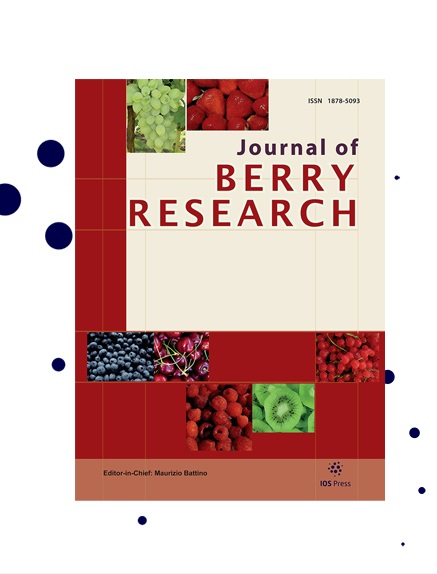花的形态特征及其来源对金银花品种杂交可能性的评价
IF 1.4
4区 农林科学
Q3 PLANT SCIENCES
引用次数: 2
摘要
背景:Haskap (Lonicera L.)是一种生长在温带气候条件下的前景广阔的浆果新品种。根据目前的认识,哈斯卡普是一种完全自育的植物,因此需要对其传粉方式进行研究。目的:从异花授粉的匹配性方面对加拿大和俄罗斯的哈斯卡普新品种进行评价。方法:选择不同品种交叠开花时间进行互花授粉。通过雌蕊组织的花粉管过度生长和坐果质量来评价授粉效果。结果:俄罗斯品种开花时间明显早于加拿大品种。柱头在刚开放的花期和花药破裂后最容易接受。浆果质量上可接受的最小重量是1克,这相当于果实中大约6颗种子的形成。亲和度最高的品种是‘极光’ב朱加纳’、‘极光’ב西尼吉乌特’和‘极光’ב沃斯托尔格’。结论:俄罗斯品种开花时间明显早于加拿大品种,花期柱头最易受感,果实质量最小可接受重为1 g(果实中6粒种子),最佳互花授粉品种为同一育种群内品种(俄罗斯x俄罗斯和加拿大x加拿大)。本文章由计算机程序翻译,如有差异,请以英文原文为准。
Evaluation of morphological traits of flowers and crossing possibility of haskap (Lonicera L) cultivars depending on their origin
BACKGROUND: Haskap (Lonicera L.) is as a new perspective berry species for growing in temperate region climate. According to nowadays knowledge haskap is absolutely self-sterile species hence the studies on pollination mode are required. OBJECTIVE: The aim was to evaluate new haskap cultivars of Canadian and Russian origin in terms of their matching for cross-pollination. METHODS: The overlapping of flowering time of cultivars for mutual cross pollination was selected. The effectiveness of pollination was assessed: in terms of pollen tube overgrowth through the pistil tissue and the quality of set fruit. RESULTS: The Russian cultivars bloomed much earlier than the Canadian cultivars. The stigma is most receptive in the freshly open flower stage and directly after the anther burst. The minimum qualitatively acceptable weight of a berry is 1 g, which corresponds to the formation of about 6 seeds in the fruit. The most compatible pairs of cultivars were: ‘Aurora’בJugana’, ‘Aurora’בSinij Utes’ and ‘Aurora’בVostorg’. CONCLUSION: The Russian cultivars bloomed much earlier than the Canadian cultivars, the stigma is most receptive in the freshly open flower, minimum qualitatively acceptable weight of berry is 1 g (what represents 6 seeds in fruit), best mutual pollinating cultivars are the cultivars within the same breeding group (Russian x Russian and Canadian x Canadian)
求助全文
通过发布文献求助,成功后即可免费获取论文全文。
去求助
来源期刊

Journal of Berry Research
Biochemistry, Genetics and Molecular Biology-Biochemistry
CiteScore
3.50
自引率
11.80%
发文量
21
期刊介绍:
The main objective of the Journal of Berry Research is to improve the knowledge about quality and production of berries to benefit health of the consumers and maintain profitable production using sustainable systems. The objective will be achieved by focusing on four main areas of research and development:
From genetics to variety evaluation
Nursery production systems and plant quality control
Plant physiology, biochemistry and molecular biology, as well as cultural management
Health for the consumer: components and factors affecting berries'' nutritional value
Specifically, the journal will cover berries (strawberry, raspberry, blackberry, blueberry, cranberry currants, etc.), as well as grapes and small soft fruit in general (e.g., kiwi fruit). It will publish research results covering all areas of plant breeding, including plant genetics, genomics, functional genomics, proteomics and metabolomics, plant physiology, plant pathology and plant development, as well as results dealing with the chemistry and biochemistry of bioactive compounds contained in such fruits and their possible role in human health. Contributions detailing possible pharmacological, medical or therapeutic use or dietary significance will be welcomed in addition to studies regarding biosafety issues of genetically modified plants.
 求助内容:
求助内容: 应助结果提醒方式:
应助结果提醒方式:


